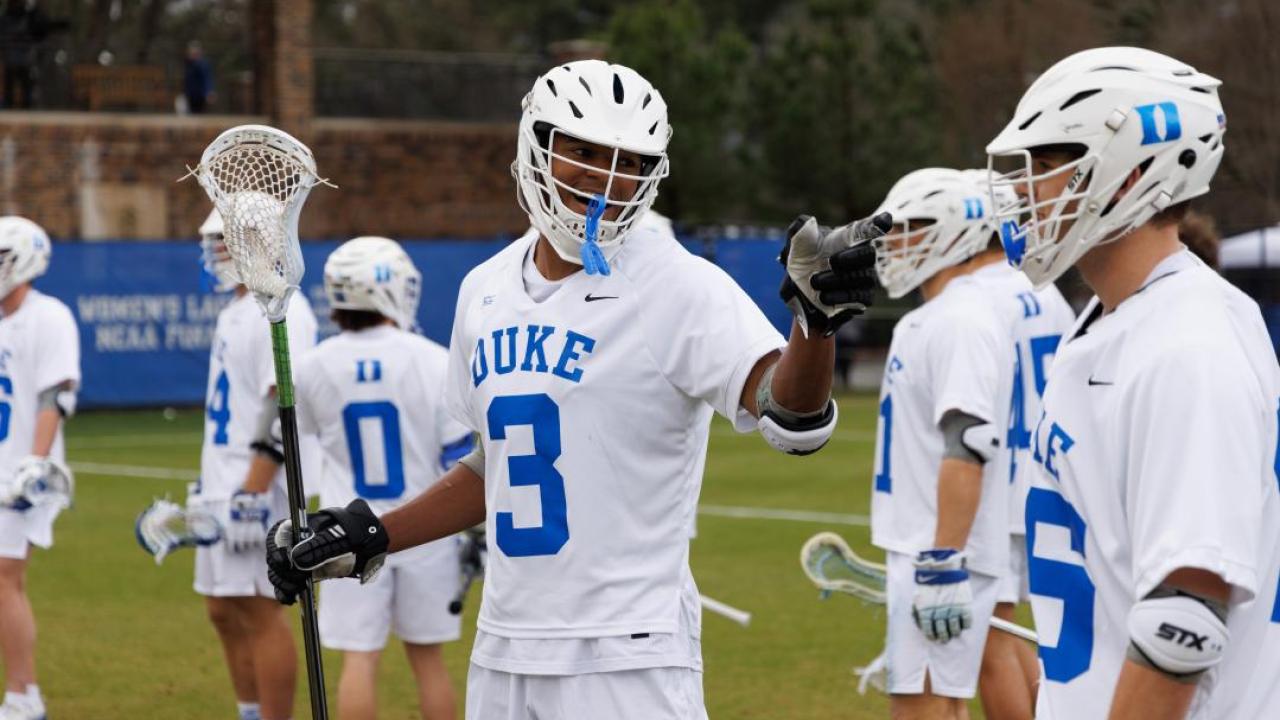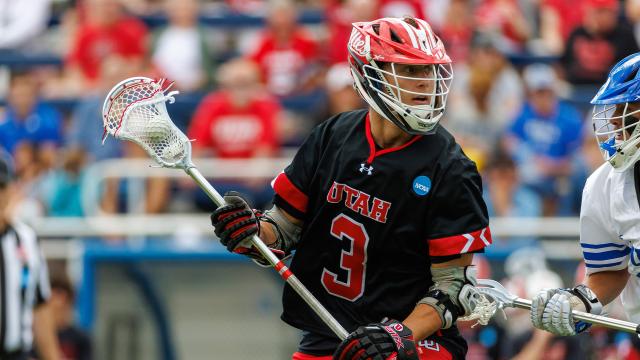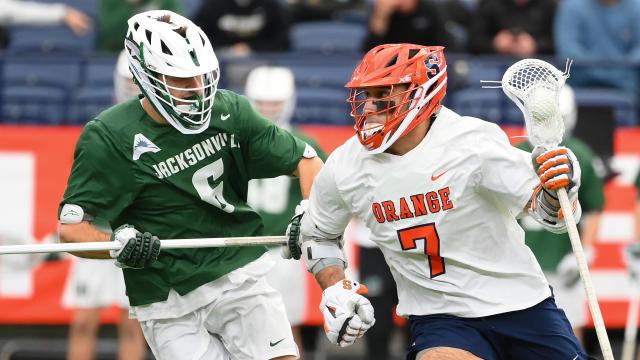
Grading the Committee: Uncontroversial Bracket With Simple Explanations
The explanations were concise and direct, the bracket largely uncontroversial.
After the ruckus raised last year on Selection Sunday with a six-pack of Ivy League teams and the exclusion of Duke and Notre Dame, this season’s bracket reveal was downright sedate.
Oddly enough, it stemmed from the chaos sown by Michigan (Big Ten champions) and Princeton (Ivy champions) in their respective tournament.
“Denver was first out, without question,” said Denver deputy athletic director Brandon Macneill, the chair of the five-person selection committee. “Penn was second out. Then Villanova and Rutgers were looked at, but those two were slated in pending bid steals. Then Michigan bumped Penn, and then Princeton bumped Denver.”
Simple as that.
There was also solid early agreement on the ordering of Duke, Virginia and Notre Dame, the top three seeds. Macneill said Wednesday’s call with the 10-coach regional advisory committee provided especially valuable feedback on that front, and nothing changed over the weekend to change the order.
“The overwhelming majority of the RAC had Duke-Virginia-Notre Dame,” Macneill said. “We, as a committee, took that and said, ‘OK, well that’s the thinking’ and we agreed to it. When it all shook out, Duke by far was the No. 1 RPI. Virginia and Notre Dame were a lot closer to each other than Duke was to either of them. And then when you have the two head-to-heads, how could you possibly argue it any other way?”
One interested party in this is someone who has spent much of the last year studying the selection process. Virginia coach Lars Tiffany had no quibbles about the Cavaliers landing a No. 2 seed behind their longtime nemesis Duke.
“All week, some people were like, ‘Lars, I think they could put you 1,’” Tiffany said. “And I said, ‘If they make me 1, I’m going to punch somebody in the nose.’ They have a better RPI and they beat us twice. In so many ways, I can see their logic. It made sense.”
Macneill said the next band of teams included Maryland, Penn State, Johns Hopkins and Georgetown, with an apparent gap after that to eighth-seeded Cornell, unseeded Yale and others.
For teams seeded fourth through seventh, there was clearly a great deal of value placed on head-to-head results.
“Maryland had the best win of anybody [in that group], over UVA, they got to the championship game and they had the head-to-head over Penn State,” Macneill said. “As simple as this may sound, Penn State had the head-to-head over Hopkins. Then Georgetown’s best win was Denver. Georgetown’s worst loss was Penn, so they’re awesome. They just didn’t have the top-five wins that [others] had.”
The committee also produced a relatively cost-contained bracket. Only two teams — Michigan (to Cornell) and Utah (to Notre Dame) — will require flights to their first-round destinations.
THE FAVORITES
The ACC powers
Who else? Duke, Virginia and Notre Dame separated themselves from the rest of the field this season, and they’re rightfully the top three seeds. They were a combined 29-2 against everybody else, with the lone blemishes coming when Duke tripped up at Jacksonville on Feb. 11 and Virginia fell at home to Maryland on March 18.
LAST TEAM IN
Yale
The bracket sort of gives it away. Yale is the only at-large team playing on the road, so it had to be the last team in the field. Macneill said it wasn’t particularly close. From the outside looking in, it would have been difficult to choose a Denver team with a worse RPI and a head-to-head loss to the Bulldogs (11-9 on March 11).
“There was no question on Yale over Denver,” Macneill said.
There was nonetheless probably a little anxiety in New Haven. Yale, which lost 19-10 to Princeton in Sunday’s Ivy League title game, was the last team revealed during the selection show.
FIRST TEAM OUT
Denver
There would be a very different conversation if Yale had beaten Princeton in the Ivy final. Or if Michigan fell to Maryland in the Big Ten title game. Or, of course, if Denver had won the Big East tournament.
Instead, Pioneers coach Bill Tierney’s career ultimately ended with a 14-5 loss to Georgetown on Saturday before an announced crowd of 334 in Milwaukee. It was remarkably anticlimactic for a Hall of Famer who led Princeton to six national titles and tacked on another in 2015 at Denver.
“You feel for Coach T,” Maryland coach John Tillman said. “I’m a big coach Tierney fan and respect him a lot. Certainly, he’s a legend and part of you would like to see him be in this tournament just because of what he’s done for the sport. Penn is right there and a dangerous team. I think if anybody played them, they’d be a tough out and they would give you some problems. I almost wish we had a bigger tournament because I think there were a lot of teams that were deserving that aren’t going to get the opportunity and are disappointed.”
TOUGHEST DRAW
Penn State
There aren’t exactly a bunch of “easy” draws floating around, but the fifth-seeded Nittany Lions get to sit around all weekend and wait for the Sunday night slot — the one that’s seen the home team lose in three of the last four NCAA tournaments. They’ll also face Princeton, which looks like it has figured things out after edging Penn and hammering Yale in the Ivy League tournament in New York.
If Penn State gets through, it could play a de facto road game against Maryland in the quarterfinals in Annapolis, Md. The Nittany Lions are plenty capable of making it to the semifinals, but there’s little doubt they’ll have to earn it.
UPSET ALERT
Army vs. Maryland
Good luck finding an unseeded team in this tournament more consistent than Army. The Patriot League champions have been in every game, and their three losses are by a combined four goals. The Black Knights have scored between 10 and 12 goals in eight of their last nine games. They’re steady everywhere and deep on offense. You know exactly what you’re going to get.
Contrast that to Maryland, which has yo-yoed all over the place throughout the season. The ceiling is high and the floor is low in College Park, and that’s a very dangerous thing for the Terrapins considering who their buttoned-up opponent is.
“I think lacrosse is at a spot now where everybody is good,” Tillman said. “There are no easy games. Everybody has talent, everybody is well-coached, everybody is prepared. You have to go out and play a really good game if you hope to advance.”
Here’s the counterargument: Maryland hasn’t authored back-to-back duds all season, and it is coming off its most lopsided loss since 2006. The Terrapins are more than capable of winning, but no one should anticipate a blowout.
ABOUT THOSE QUARTERFINAL SITES
The single most puzzling part of the bracket has nothing to do with who was selected or how they were seeded. It’s where the top two seeds are heading if they advance to the quarterfinals. Both Duke and Virginia were sent to Albany, N.Y., rather than a closer-to-home assignment in Annapolis, Md.
“When we realized that about 10 minutes later, we were like, ‘That’s got to be a mistake,’” Tiffany said. “That was literally our first reaction. Why would they have Duke and Virginia, assuming we win, flying to Albany? I don’t have to look it up. I go to Lake Placid every August. I know from Charlottesville, I’m about 9-10 hours into my trip when I’m driving through Albany, so I know that’s over 400 miles.”
So what’s the deal? This is one thing the five members of the selection committee aren’t tasked with. Their priority is seeding the top eight teams, choosing the at-large teams and then bracketing the field.
“They ask our opinion a little bit, but a lot of it’s with the TV,” Macneill said. “It probably has to do with ticket sales and what not. We were asked about it, but we did not focus much surrounding that issue.”
PAYBACK TIME
Richmond at Virginia
It’s the only rematch of a regular season game, and what a forgettable contest that was — at least for Richmond, anyway. Virginia earned a 25-8 victory back on March 4, getting six goals from Xander Dickson to avenge last year’s 17-13 loss in Richmond.
The first round isn’t steeped in much postseason history; only three matchups that could be reprises of previous NCAA tournament encounters. Yale defeated Georgetown 19-16 in the 2019 first round. Duke beat Delaware in the first round in 2011. And Army and Maryland have split a pair of first-round games, with Army winning in 1993 and Maryland upending the Black Knights in 2004.
NAMES TO KNOW
FO Cole Brams, Utah. If the Utes and their explosive offense are going to do damage, they’re going to need to win a lot of possessions. Enter Brams, who was 21 of 23 against Air Force on Sunday to earn A-Sun tournament MVP honors. He’s won 59.1 percent on the season and goes up against a Notre Dame faceoff unit that ranks 60th nationally in winning percentage at 44.1 percent.
A Matt Brandau, Yale. He isn’t the Bulldogs’ leading goal scorer (that’s Chris Lyons with 58), but he is their barometer. In Yale’s nine victories, Brandau has 28 goals and 25 assists, good for nearly six points a game. In five losses, he has six goals and six assists. He’s the straw that stirs the Elis’ drink at the offensive end.
A Tucker Dordevic, Georgetown. No one symbolizes the way the Hoyas’ revamped offense needed time to figure things out than the Syracuse graduate transfer. He shot 26.4 percent in his first eight games and is at 45.8 percent in the seven games since. Oh, and he has 57 goals in his lone year at Georgetown.
A Jamison Embury, Marist. The graduate student just had 15 goals and four assists in the Red Foxes’ three-game run to the Metro Atlantic title. He’ll be someone to keep an eye on when Marist visits Delaware in Wednesday’s play-in game.
D Owen Grant, Delaware. Tempting though it was to select attackman Tye Kurtz (49 G, 27 A) as the Blue Hens’ representative on this list, the nod goes to the three-time CAA defensive player of the year. Yet again, he’s one of the 10 best close defensemen in the country.
A Johnny Hackett, Bryant. The America East rookie of the year enters the postseason with 40 goals and 12 assists. He’s one of five Bulldogs with at least 40 points.
G Michael Gianforcaro, Princeton. Despite the graduation of Erik Peters, Tigers coach Matt Madalon felt good about his goalie room in the offseason. For good reason, it seems. Gianforcaro didn’t take over full-time duties in the cage until mid-March and owns a .592 save percentage, including a .634 mark over the last five contests.
A CJ Kirst, Cornell. He leads the country in goals with 63, and that only provides a glimmer of the value he provides the Big Red. Between him on attack and Gavin Adler on defense, Cornell might have the best player in the country at two different positions.
A TJ Malone, Penn State. The Nittany Lions don’t have a ton of stars, but they are deep and have plenty of useful pieces. Malone (27 G, 28 A) is one of nine players with at least 13 points for Penn State.
D Alex Mazzone, Johns Hopkins. What a massive boost Mazzone has provided on both faceoff wings and close defense for the Blue Jays. A long stick midfielder at Georgetown before joining the Blue Jays as a graduate transfer, Mazzone is a major part of Hopkins’ revitalization this season.
G Matthew Nunes, Virginia. The sophomore has played better in the second half of the season, and he had a career day in the Cavaliers’ regular-season finale. His 19 saves helped Virginia upend Notre Dame 12-8. If the Hoos get more of that, a third title in four tournaments could be in play.
A Brennan O’Neill, Duke. The likely Tewaaraton finalist heads into the postseason with 44 goals and 36 assists, and he was held to less than three points just once all season (when he scored once against Notre Dame). O’Neill can be both a finisher and a distributor, and teams will have to choose wisely how to deal with him.
D AJ Pilate, Army. The sophomore is the Patriot League’s defensive player of the year, and his motor makes him a fitting successor to some of the great defensive players to pass through West Point. He’s adept at not only separating a ball from a foe, but also a stick from an opponent as well. He’s well-equipped to handle a high-profile matchup or two in Army’s first NCAA appearance since 2019.
G Hunter Taylor, Michigan. The freshman played the final game and a half of the Big Ten tournament, posting a .688 save percentage as the Wolverines got past Penn State and then bludgeoned Maryland. Might Michigan ride its goalie even deeper into the postseason?
M Brian Tevlin, Notre Dame. The Irish’s star is attackman Pat Kavanagh, and there is a lot to like about the probable Tewaaraton finalist (including his relentless riding). But Tevlin is the sort who could pop up on the field at any time — on the first midfield, on faceoff wings, on a defensive shift, even man-down with a pole in his hand. The grad transfer from Yale is arguably the best Swiss Army knife in the postseason.
A Dalton Young, Richmond. In addition to forever being the answer to a trivia question (who is the first offensive player of the year in Atlantic 10 men’s lacrosse history), Young has 30 goals and 39 assists for the Spiders. He’s collected at least seven points in five of Richmond’s last eight contests.
FO Luke Wierman, Maryland. The reason the Terrapins were borderline unstoppable last season was Wierman repeatedly gave possession to a lethal offense. He was a luxury in 2022 and a necessity this season since Maryland doesn’t have dominant offensive personnel. Wierman is at 61.4 percent at the X in 2023, and the Terps need that sort of production in the postseason.
DON’T BE SURPRISED IF …
Georgetown-Yale is absolutely bonkers
Georgetown has won 12 in a row and scored at least 12 goals in every game during that run. Yale has won games by margins of 20-14 (Villanova), 17-14 (Boston U), 21-11 (Dartmouth) and 22-15 (Cornell) and lost games by scores of 20-10 (Cornell), 23-10 (Princeton), 17-16 (Penn) and 19-10 (Princeton again).
Whatever the outcome, expect a bunch of goals to be scored in Saturday’s third game.
YOU’LL HEAR A LOT ABOUT …
Prominent teams returning to the NCAA tournament
The headliners, of course, are top-seeded Duke and third-seeded Notre Dame, which saw lengthy postseason streaks end last season. But Penn State and Johns Hopkins landed top-six seeds and will make their first postseason appearances since 2019.
This isn’t a complete restoration of classic contenders. Syracuse has missed back-to-back tournaments for the first time since it made its initial appearance in 1979, and three schools that have won titles since 2012 (Loyola, Denver and North Carolina) are on the outside looking in.
Still, the experience of sitting at home last May had to provide at least some fuel for Duke and Notre Dame heading into this season. It is certain to be mentioned more than a few times.
PREDICTIONS
1. The top three seeds reach Memorial Day weekend. Nothing fancy here, given how well Duke, Notre Dame and Virginia have fared all season. The top three seeds advanced to the semifinals in three consecutive tournaments (2018, 2019 and 2021) before second-seeded Georgetown and third-seeded Penn were upended early last season.
2. There will be some grousing in the Midwest about what amounts to a road game in the quarterfinals. If there is a chalky first round, third-seeded Notre Dame would face sixth-seeded Johns Hopkins in Annapolis, Md. The Irish easily could have been funneled into Albany, making this avoidable (unlike two years ago, when Notre Dame had hosting duties and was going to get a home game regardless of how it was seeded).
3. There will not be a first-time semifinalist. The only teams in the field that haven’t played on championship weekend are Bryant, Marist, Michigan, Richmond and Utah. All of them must win a road game simply to get to the quarterfinals. Michigan is especially intriguing, but here’s guessing we’ll see some relatively familiar names in Philadelphia.
GRADING THE COMMITTEE
A
A lot of the hard decisions were made for this year’s committee thanks to the bid-thieving antics of Michigan and Princeton. Choosing Denver over Penn would have created a spirited debate. Picking Yale over Denver for the last spot really doesn’t.
The pairings were also fairly easy to deduce in advance. Utah had to fly somewhere; it might as well be to Notre Dame, which was going to need someone to fly to it in any bracket with competitive integrity. Michigan couldn’t play a Big Ten school in the first round, so its destinations were basically limited to Georgetown and whichever Ivy League school grabbed the last seeded spot (Cornell, in this case).
The only team seeded between Nos. 3 and 7 that Bryant could bus to within a 400-mile radius was Johns Hopkins. All of the Ivies could bus to Georgetown, but with the committee looking to avoid rematches when possible, Princeton was steered away from Georgetown and Maryland and sent to Penn State. That meant Yale went to Georgetown, Army was left to go to Maryland and Richmond was shipped to Virginia.
So, unlike last year, there aren’t many grumbles about the finished product. But Macneill, who was a part of the committee that produced last year’s lightning bolt, insisted the difference in creating the two brackets was nonexistent.
“We went through the exact same process yesterday — exact same process,” Macneill said. “And if Princeton and Michigan didn’t win, this process would have had Denver and Penn in there, and it would have been the exact same process. I think we have some names that are maybe a little more familiar than they were last year. For the most part, it’s the same group, and we went through the exact same deal.”
Patrick Stevens
Patrick Stevens has covered college sports for 25 years. His work also appears in The Washington Post, Blue Ribbon College Basketball Yearbook and other outlets. He's provided coverage of Division I men's lacrosse to USA Lacrosse Magazine since 2010.

Related Articles




